|
|
|
Information about
Kolkata |
|
Kolkata, formerly known as Calcutta is the capital of West Bengal. Kolkata is the India's largest, friendliest and metropolitan city. The city abandoned its British imposed name of Calcutta in December 2000 and restored its traditional identity as Kolkata. The name Kolkata is said to be derived from the name Kalikshetra or the seat of goddess Kali. Kolkata is located at the tip of sprawling Ganges delta, which flows into the Bay of Bengal. Kolkata covers an area of 1380 square km. Kolkata, the city of palaces was founded by the English merchant trader Job Charnock in 1690. Kolkata is certainly a new city, only 300 years old. It is a European city, planted on the soil of Asia, though the inhabitants are brown and clad in white dhoti and kurta. It was at one time, the industrial, cultural and intellectual hub of the country. It is also regarded as cultural capital of India. The Ronald Ross, Rabindranath Tagore, CV Raman, Gunter Grass, Mother Teresa and Amartya Sen are the various famous personalities that belongs to Kolkata. The Howrah bridge which connects the city to an industrial township is the main land mark of Kolkata. Bengali, Hindi, English, Oriya and several other minor and tribal languages such as Santali are spoken in Kolkata. The best time to visit Kolkata is between October and February when the weather is the most pleasant. Various places of historical, ethnic and cultural interest and wildlife sanctuaries can be easily reached from
Kolkata. |
|
|
|
|
History of Kolkata |
|
The first recorded information on Calcutta was found in the Ain–I–Akbari in 1596. The Bysacks, traditional weavers of Bengal, and Seths, the merchant bankers had established Sutanati, which was the ‘Cottonopolis’ of Bengal. Calcutta grew around the villages of Kalikata, Sutanati, Govindapur and Chitpore on the east bank of the Hooghly river and Salika and Betor on its west bank. Calcutta was founded by the English merchant trader Job Charnock in 1690. Job Charnock was the first Governor of Calcutta. It is also said that Calcutta’s existence hangs on a doctor’s prescription. In 1640, Gabriel Boughton, an English surgeon, effected a royal cure for which the fee asked for and granted was the Mughal Emperor Shah Jahan’s concession of free trade in Bengal. The permission was granted to the East India Company to purchase the three villages of Sutanati, Kalikata and Govindpur in the immediate neighbourhood of the Fort. The negotiation price was Rs.16,000 and the purchase price in 1690 was Rs.1300. The company became landowners with a landlord’s prerogatives and built the Fort William. This first fort was named after King William III and completed in 1707. The Union Jack was hoisted for the first time in 1707 on Fort William. In 1742, the chief threat to Calcutta's safety was posed by the Marathas and this led to the digging of the five km Maratha Ditch, from when the Ditcher came to be coined and applied to the Anglo – Indian. This city was later taken over by the Siraj-ud-Daula, the Nawab of Bengal for a short time. But in 1756, the Siraj-ud-daula was defeated in the battle with the British and the city was later taken over by the Robert Clive and Admiral Waston from Madras, and the Battle of Plassey in 1757 was a victory of British diplomacy and intrigues. In 1773, the capital was transferred from Madras to Calcutta and it grew into the second city of the Empire. In 1803, Lord Wellesley constituted an improvement Committee for the city that a decade later became the Lottery Commission, which by running lotteries raised funds for buildings such as the Town Hall, which still stands today, and a number of new roads. It was James Atkinson who in 1824 first gave Calcutta the title of “City of Palaces”. From the mid 19th century, the individual free traders were brought to Calcutta. Tramways and street lighting appeared. The town of Howrah was linked to Calcutta by a pontoon bridge in 1874. When the British strengthened Fort Williams in 1780, they cleared the vast jungles for target practice from the Fort and to prevent any sneak invasion. It was around and near the Maidan that the city started coming up. It was also here that they decided to build the Victoria memorial to the British Empire. Gradually, the whole of India came under the British rule and Calcutta continued to be the capital of India, even when the Company forfeited the empire to the British throne. In order to weaken Bengali solidarity, Lord Curzon partitioned the state into two parts, East and West Bengal, in 1905. But the resultant agitation forced him to withdraw the order 5 years later. However, the British divided Bengal at the time of their daparture, with the consent of the Congress and Muslim League parties. In 1947, due to partition, only 88000 square kms was left with Calcutta as its capital, and Bangladesh, got an area of 1,44,000 square kms and Dhaka became the capital of Bangladesh. In 1960, the serious problems arose in Calcutta. The problems were worsened by the outbreaks of the violence organised by a revolutionary political movement known as Naxalites. The election of the Communist Party of the India Marxist to power in 1977 has been followed by a period of stability for the city and there were some signs of growth in the city. |
|
|
|
|
Economy of Kolkata |
|
Kolkata is still a major centre for business, industry, trade and exports. It accounts for over 80 per cent of the total production of jute goods in the country. The majority of 70 jute Mills of India lie on the two banks of the Hoogly, about 48 km. north and south of Kolkata.The trade in jute, tea and the industries that flourished in the city's hinterland due to the rich mineral deposits of iron ore, manganese and limestone continued to play an important role in the economy of West Bengal. Kolkata’s role in the national economy is as crucial as the gateway to Eastern India. The discovery of coal at Raniganj in the second decade of the 19th century was one of the most significant contributory factors behind the process of industrialization in eastern India. Kolkata naturally developed into a focal point of the engineering industry in the country. Some heavy engineering, car manufacturing and ship buildling industries continued, but main emphasis was on the electronics and lighter consumer industries. India is the world’s largest producer, consumer and exporter of tea and the bulk of the country’s exports of tea are shipped from Kolkata. The major quantity of high quality Darjeeling tea is sold through Kolkata. During the 1950, the industrial importance of Kolkata grew with the rapid development of the Durgapur–Asansot belt. In quick succession came the integrated steel plant at Durgapur, the Alloy Steels Plant, the Chittaranjan Locomotive Works, the Mining and Allied Machinery corporation, the first telecommunication cables manufacturing plant in India at Rupnarainpur and other large units to exploit the high mineral resources of this region. As high as 70 per cent of the railway wagons produced in the country come from units located in and around Kolkata. One of the biggest suppliers of textile machinery is located near Kolkata. Leather tanneries located in the city account for over 25 per cent of the country’s leather exports. |
|
|
|
|
Shopping in Kolkata |
|
Shopping is not easy in Kolkata but it can be very rewarding. Bengali silver and gold smith is the best in the whole of India. Kolkata is also known for its silk and cotton saris and fabrics. There is a huge variety of gaily striped cottons, embroidered bedspreads and woolen blankets. The Baluchari brocade saris are now collector’s items. These saris were made in Murshidabad and takes about six months to one year. The designs on the saris are beautiful and typically Bengali. It is also a centre for the manufacture of musical instruments. All kinds of musical instruments can be bought here. Among Bengali crafts, traditional terracotta figures are made in village throughout the state. New Market, the Kolkata’s oldest municipal market, offers leather goods, plastic toys, fancy silverware, jewellery, garments, fabric, confectionery, clothes, dry fruits, poultry products, fish, meat, flowers etc. Gariahat, Bou Bazaar, Bara Bazaar, Haati Bagan are the best places to hunt for sarees, especially the famous Bengali “Baluchoris”. Dakshinapan Market is well known for its hand looms, textiles, handicrafts, cosmetic jewellery, fancy goods, objets d’art, etc. |
|
|
|
|
Festivals of Kolkata |
|
Durga Puja is the most important and famous festival which is celebrated in Kolkata. Besides this, Ganga Sagar Mela, Netaji Subhash Chandra Bose Jayanti, Basanta Panchami, Bengali New Year, Rabindra Jayanti and Christmas are the famous festivals which are celebrated in
Kolkata. |
|
|
|
|
Tourist Attractions in Kolkata |
|
Victoria Memorial
Victoria Memorial is a grand white marble building planned by Lord Curzon and inaugurated by the Prince of Wales in 1921. This building has tree-lined walks, splendid parks, lakes and superb statue including that of Queen Victoria. This building was designed in the Italian renaissance cum saracenic style and built of white Makrana marble from Rajasthan. This building is often known as the Taj Mahal of the British Raj and built in the memory of Queen Victoria. This memorial is surmounted by a crowning dome, a huge bronze revolving Angel of Victory which functions as a weather cock. The memorial has collection of the items of the British Raj, piano and desk of the Queen Victoria, books, portraits and paintings of Reynolds, Zoffany, Daniell and Emily Eden, miniatures, Persian manuscripts, portraits of national leaders and reminders of the military conflicts. |
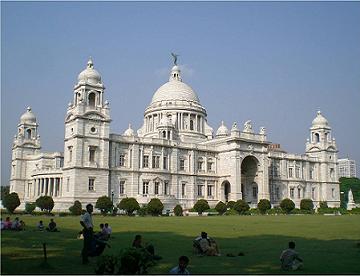 |
|
|
|
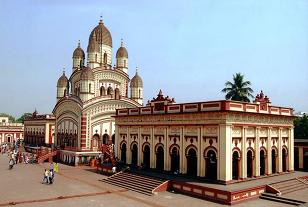 |
Dakshineshwar Kali Temple
The Dakshineshwar Kali Temple is situated on the opposite side of the river from Belur Math alongside the Vivekananda bridge. This temple was built in 1947 by Rani Rashmoni. Rani Rashmoni received divine directions in a dream to build the Kali temple at Dakshineshwar. The saint Sri RamaKrishna lived and worshipped here. The Kali temple has 12 spires and 12 other smaller temples in the large courtyard are dedicated to Shiva and Radha Krishna. Non-hindus are not permitted inside the temple. |
|
|
|
|
Howrah Bridge
Howrah Bridge or the Rabindra Setu was opened in 1943. This single span cantilever bridge replaced the old pontoon bridge which joined the city with its main railway station and the industrial town of Howrah. This bridge is also the main landmark of Kolkata. To avoid affecting river cuurents and silting, the 280 m high piers rise from the road level and the span between them is 450 m. The Howrah bridge is one of the longest and busiest bridge in the world. There are 8 lanes of traffic and 2 foot paths which are always packed with vehicles and pedestrians. |
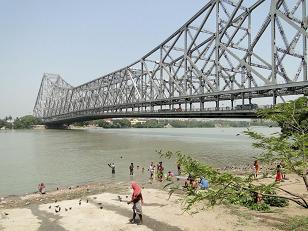 |
|
|
|
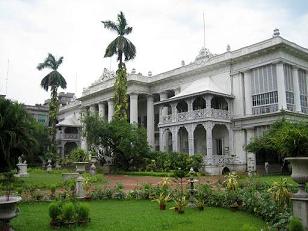 |
Marble Palace
The Marble Palace is a fantastic piece of architecture built by Rajendra Mallik and located in north
Kolkata. The Marble Palace was formerly known as the Palace of Arts and was named as Marble Palace by Lord
Minto. The Marble Palace is an ornate building with Italian courtyard, classical columns and a large tank with fountain and Egyptian sphinxes. This
palace has a one man collection of art treasures and huge collection of artifacts. The entrance is through a courtyard where one is greeted by mynahs and macaws from the aviary. There are about ninety different kinds of marbles from near and far, used in every part of the palace especially on the patterned floors |
|
and cool white walls. The long galleries are crammed with statues,
pottery, mirrors, chandeliers and English, Dutch and Italian paintings. In the garden, there is some statue with six sleeping lions gracing the lawns. A part of the extensive garden has been now treated as the first zoo of
Kolkata. |
|
|
|
|
Nakhoda Mosque
Nakhoda Mosque is the largest mosque in the city of
Kolkata. This mosque can accommodate 10000 worshippers. This mosque was built between 1926 and 1942 of red sandstone. It is a
four-storey structure that reminds of the Akbar's tomb in
Sikandra. The mosque has huge blue and white painted domes flanked by the 246 m minarets.
Joransako
Joransako is the home of the merchant Prince Dwarkanath Tagore and his illustrious grandson Rabindranth
Tagore. This place is also the Rabindra Bharati University and Museum. |
 |
|
|
|
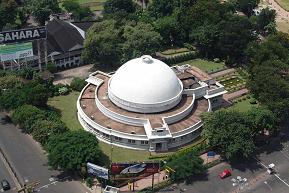 |
MP Birla Planetarium
The MP Birla Planetarium is located on the eastern side of the Maidan in the Chowringhee area of
Kolkata. This planetarium is one of the largest in the world and an ideal spot to have respite from the city life of
Kolkata. It is also an ideal place to sit back and relax and take in a spectacular view of the sky of
Kolkata.
B.B.D. Bagh
B.B.D. Bagh or Benoy Badal Dinesh Bagh was earlier known as Dalhousie Square and renamed after 3 Bengali martyrs,
Benoy, Badal and Dinesh. This square was created in the imperial capital with a small artificial lake in the centre fed by |
|
natural springs.
It is also believed that the John Charnock
used to obtain drinking water from this tank.
Today, many historic buildings surround the
square like the Writer's buildling, General
Post office, Raj Bhawan, Vidhan Sabha,
Calcutta High Court, St. John's Church, etc. |
|
|
|
|
Eden Garden
The Eden Gardens are the famous cricket grounds in India and often referred as the Cricket's Madina. The enthusiastic and excitable temperament of the Bengali fan who descends in herds has probably helped it gain this reputation. This garden was named after the Lord Auckland’s sister, Eden. The Eden Gardens used to be a lush green area covered by trees and gardens. The area also has a tiny Burmese pagoda set in a small lake.
Belur Math
Belur Math is the international headquarters of the Ramkrishna Mission, the monastic order of Sri Ramakrishna. This mission |
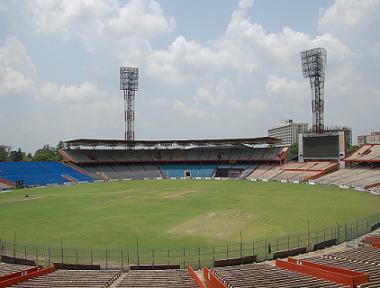 |
|
was founded in 1899 by Swami Vivekananda who was a great disciple of the great 19th century
Hindu saint
Ramkrishna. The architecture represents a
church, a mosque and a temple when viewed from
different angles, which synthesize the Hindu,
Christian and Islamic styles of
architecture. |
|
|
|
|
The Maidan
Maidan, the huge expanse of green space was originally designed as the most imposing feature of Fort William. About 200 years ago, the maidan was covered in the dense jungles. Tigers, crocodiles and many other wild animals were common here. But today, it is a green garden and constitute the lungs of Kolkata and cover over 400 hectares in the heart of the city. This vast green park is a popular destination for jogger’s, morning walkers and tourists. Many of Kolkata’s sporting clubs, the Fort William, the Ochterlony monument, also known as Shahid minar is located in the Maidan. The Ochterlony Monument was erected in 1828 as a memorial to Sir David Ochterlony, the hero of the Indo – Nepalese war and was later renamed as Shaheed Minar to remember those who died for the freedom of the country. It rises over 150 feet and an Egyptain plinth crowned by a Turkish cupola. |
|
|
Fort William
The British built a massive fort in 1756 to replace the original fort at Calcutta and renamed as Fort William after the King William III. This fort was completed around 1781 on the site of the old village of Govindapur. This fort was designed to be impregnable in the shape of a roughly octagonal plan, about 500 m in diameter. This fort was built so as to make it large enough to house all the Europeans in the city in case of an attack. One of the five entrances of the fort was a water jetty. The St. Peter's Church, the barracks and stables, arsenal, prison and strong rooms still remains in the fort. |
|
|
Kali Temple
The Kali Temple is situated in Kalighat. This temple is an important Hindu pilgrimage centre. This temple is dedicated to the goddess Kali, the patron goddess of Kolkata. This temple was re-built in 1809 over the site of an older temple which marked the spot where the goddess toes is said to have fallen when Shiva was carrying her charred corpse and she was cut into pieces by Vishnu's chakra. This temple draws the largest number of devotees, especially on festive occasions such as the Bengali New year and Durga Puja. |
|
|
Botanical
Gardens
The Botanical garden is located on the banks of river Hooghly. This garden was created by Col. Alexander of the East India Company as a pleasure retreat in 1787 and covers over 272 acres of land. The main attraction of this garden is a 250 year old banyan tree with a circumference of over 380 m, which is one of the widest canopies and largest tree in the world. This garden houses over 35,000 varieties of plants. There are exotic varieties of plants in herbarium, fern, cacti and orchid houses and the 16 m domed palm house. |
|
|
|
|
|
How to reach Kolkata |
|
A vast network of airways, railways and highways originate form Kolkata, the gateway of eastern India.
By Air:
Kolkata is an international airport connected with all parts of the world. Indian Airlines connects Kolkata with various important airports in India like Delhi, Mumbai, Chennai and Jaipur. Major private airlines are also operated to Kolkata. Kolkata’s Netaji Subhash Chander Bose International Airport is about 20 kms from the city centre.
By Rail:
Kolkata is connected by rail with all the major cities and towns of India. The mtero rail is the famous train which was started in 1984 and operates only in Kolkata. These trains are very clean, punctual and efficient and the stations are also air-conditioned.
By Road:
Kolkata is connected by road to Santiniketan, Siliguri, Sunderbans, Digha, Darjeeling, Puri, Bhubaneshwar and Konark. Trams are the most favourite means of transport for the people of Kolkata. Kolkata is the only city where trams are run on the roads. Kolkata is also the only city where the hand pulled rickshaws are drawn. Many of these rickshaws are hired for the day by the pullers.
To know the distances
from Kolkata
click here. |
|
|
|
|